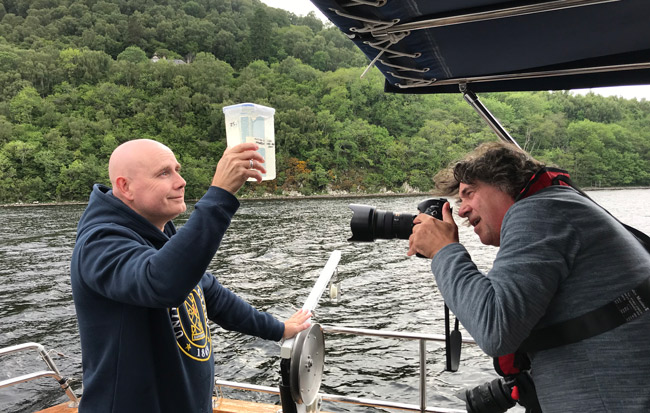Friday 6 September 2019 9:49pm

Professor Neil Gemmell at Loch Ness last June.
An Otago scientist has cast major doubt on the existence of a monster in Scotland’s Loch Ness, suggesting instead that it might be a giant eel.
Professor Neil Gemmell of the Department of Anatomy has led a major international monster hunt, travelling to Loch Ness last June to take 250 water samples from various depths, and back again this week to release the findings.
At a packed media conference at the Loch Ness Centre at Drumnadrochihe, he told the crowd that his team had not discovered monster DNA in the lake water.
One theory had been that the “monster” was a Jurassic-age reptile or population of Jurassic-age reptiles such as a plesiosaur.
"...the sheer quantity of the material says that we can't discount the possibility that there may be giant eels in Loch Ness. Therefore we can’t discount the possibility that what people see and believe is the Loch Ness Monster might be a giant eel."
“We can't find any evidence of a creature that's remotely related to that in our environmental-DNA sequence data. So, sorry, I don’t think the plesiosaur idea holds up based on the data that we have obtained,” Professor Gemmell said.
The research team tested other predominant theories of various giant fish; whether it be a giant catfish or a giant sturgeon, an eel, or even a shark such as a Greenland shark.
“So there’s no shark DNA in Loch Ness based on our sampling. There is also no catfish DNA in Loch Ness based on our sampling. We can't find any evidence of sturgeon either.”
The remaining theory that Professor Gemmell cannot refute based on the environmental DNA data obtained is that what people are seeing is a very large eel.
“There is a very significant amount of eel DNA. Eels are very plentiful in Loch Ness, with eel DNA found at pretty much every location sampled – there are a lot of them. So - are they giant eels? Well, our data doesn’t reveal their size, but the sheer quantity of the material says that we can't discount the possibility that there may be giant eels in Loch Ness. Therefore we can’t discount the possibility that what people see and believe is the Loch Ness Monster might be a giant eel.”
Professor Gemmell adds that “further investigation is needed to confirm or refute the theory, so based on our data, giant eels remain a plausible idea.”
The results come after 250 samples of water were taken around, through the centre, and into the very depths of Loch Ness. DNA from each sample was captured, extracted and sequenced then compared against global DNA databases to reveal a comprehensive picture of life present in the Loch – examining the bacteria, the fish, and everything else in between.
The “monster-factor” has provided Professor Gemmell with an opportunity to showcase the science of eDNA to the world, and the project has subsequently drawn considerable interest.
The story has been hitting international headlines today, including in the Guardian, the BBC and USA Today.
